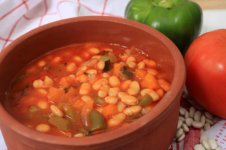Menu
Install the app
How to install the app on iOS
Follow along with the video below to see how to install our site as a web app on your home screen.
Note: This feature may not be available in some browsers.
You are using an out of date browser. It may not display this or other websites correctly.
You should upgrade or use an alternative browser.
You should upgrade or use an alternative browser.
Greek Food, Cooking and Recipe Community
What's the best Greek soup for a sick friend?
- Thread starter blopez34
- Start date
1 - 9 of 9 Posts
Thalia18NY
New member
Avgolemono alllll the way!I’m looking for a traditional soup recipe for my friend who’s sick, does anyone have any tips? He’s not feeling too well and I want to drop off something homemade.
I agree. Avgolemono. Chicken broth is medicinal.Avgolemono alllll the way!
voula_slat
Active member
I love avgolemono too, and I would also suggest something heartier like fava or a soup with beans. That’s one thing I love about Greek cooking, the use of beans! It’s so healthy, and super affordable.
1 - 9 of 9 Posts
JOIN THE DISCUSSION AND READ OTHER GREEK INFO:
Making traditional loukaniko question
- GreekGirlCooks
- Greek Food Forum
- Replies: 0
I’m on a culinary quest to master the art of making Loukaniko, the traditional Greek sausage that tantalizes taste buds with its savory blend of spices and herbs. I understand that each region and even each family might have their own special recipe passed down through generations.
Which leads me to my ask - could anyone who’s familiar with Greek cuisine share insights about the most common seasonings used in Loukaniko? I'm especially interested in any mix of spices that gives it that characteristic flavor profile.
I’ve done some preliminary research, but I’m looking for that firsthand knowledge. What's the blend that makes your Loukaniko stand out? Are there any particular secrets to perfect the authentic taste?
Which leads me to my ask - could anyone who’s familiar with Greek cuisine share insights about the most common seasonings used in Loukaniko? I'm especially interested in any mix of spices that gives it that characteristic flavor profile.
I’ve done some preliminary research, but I’m looking for that firsthand knowledge. What's the blend that makes your Loukaniko stand out? Are there any particular secrets to perfect the authentic taste?
Bougatsa Recipe - Delicious Breakfast!
- dimi_pat
- Greek Food Forum
- Replies: 0
When I was in Greece, I loved having bougatsa for breakfast. I don't have it much when I am back home so I decided to learn how to make it. Here's the recipe I use:
I do have a question, I find using the puff pastry the easiest. However, what do they use in Greece?
Dough:
I do have a question, I find using the puff pastry the easiest. However, what do they use in Greece?
Dough:
- 1 package (about 17.3 ounces) frozen puff pastry sheets, thawed
- 1/2 cup (1 stick) unsalted butter, melted
- 4 cups whole milk
- 1 cup granulated sugar
- 1 cup fine semolina flour
- 4 large eggs
- 1 teaspoon vanilla extract
- Powdered sugar, for dusting (optional)
- Ground cinnamon, for sprinkling (optional)
- Prepare the Custard Filling:
- In a medium saucepan, heat the milk over medium heat until it's hot but not boiling.
- In a separate bowl, whisk together the sugar, semolina flour, eggs, and vanilla extract until well combined.
- Gradually pour about 1/4 of the hot milk into the egg mixture, whisking constantly to temper the eggs.
- Pour the tempered egg mixture back into the saucepan with the remaining hot milk, whisking constantly.
- Cook the mixture over medium heat, stirring constantly, until it thickens to a custard-like consistency, about 5-7 minutes. Remove from heat and let it cool slightly.
- Prepare the Bougatsa Dough:
- Preheat your oven to 375°F (190°C). Line a baking sheet with parchment paper.
- Unfold the thawed puff pastry sheets onto a clean surface. Brush melted butter generously over one sheet of puff pastry.
- Place the second puff pastry sheet on top of the buttered one. Brush the top with more melted butter.
- Roll up the puff pastry sheets tightly into a log. Cut the log into 12 equal portions.
- Assemble the Bougatsa:
- Take one portion of the puff pastry and flatten it into a thin circle on a floured surface, using a rolling pin.
- Place about 2-3 tablespoons of the cooled custard filling in the center of the pastry circle.
- Fold the edges of the pastry circle over the custard filling, creating a sealed pouch. Place the filled bougatsa onto the prepared baking sheet.
- Repeat this process with the remaining puff pastry portions and custard filling.
- Bake the Bougatsa:
- Place the baking sheet in the preheated oven and bake the bougatsa until the pastry is golden brown and crispy, about 25-30 minutes.
- Remove the bougatsa from the oven and let it cool slightly before serving.
Essential Greek Pantry Staples - Your Recommendations?
- axariotisxy
- Greek Food Forum
- Replies: 0
I've recently developed a keen interest in Greek cuisine and I'm on a mission to incorporate more of its flavors into my daily cooking. Given the vast knowledge pool here, I thought this would be the perfect place to ask about must-have Greek pantry staples.
From what I gather, olive oil, olives, and feta cheese seem like obvious essentials. But I'm curious about the less obvious, yet equally important ingredients that could elevate my dishes with authentic Greek flavors.
Are there specific herbs, spices, or any other pantry items that are staples in Greek cooking? Additionally, if there are brands or types of these ingredients that you swear by, I'd love to hear about those too.

From what I gather, olive oil, olives, and feta cheese seem like obvious essentials. But I'm curious about the less obvious, yet equally important ingredients that could elevate my dishes with authentic Greek flavors.
Are there specific herbs, spices, or any other pantry items that are staples in Greek cooking? Additionally, if there are brands or types of these ingredients that you swear by, I'd love to hear about those too.

Current food trends in Greece?
- dpappas87
- Greek Food Forum
- Replies: 0
I understand that Greece is just like other countries where there might be food trends, new dishes, etc to enjoy.
I'm looking to understand more about the latest trends that are currently shaping it. I'm particularly interested in how traditional Greek recipes are being reimagined by modern chefs, how regional variations are gaining popularity, or if there's a rise in any particular ingredients or cooking methods.
Is anyone here keeping tabs on contemporary movements in Greek food? Maybe you've dined at a restaurant that surprised you with a modern twist on a Greek classic, or you've come across new food blogs with innovative recipes.
The cuisine of Greece is as much about the traditional recipes we all love as it is the trends and the way the cuisine moves forward!
I'm looking to understand more about the latest trends that are currently shaping it. I'm particularly interested in how traditional Greek recipes are being reimagined by modern chefs, how regional variations are gaining popularity, or if there's a rise in any particular ingredients or cooking methods.
Is anyone here keeping tabs on contemporary movements in Greek food? Maybe you've dined at a restaurant that surprised you with a modern twist on a Greek classic, or you've come across new food blogs with innovative recipes.
The cuisine of Greece is as much about the traditional recipes we all love as it is the trends and the way the cuisine moves forward!
Different kinds of baklava to try?
- acamp7
- Greek Food Forum
- Replies: 0
I've recently found myself on a delicious quest to explore the world of baklava, that rich, sweet pastry made of layers of filo filled with chopped nuts and sweetened with honey or syrup. I understand that baklava has roots in many culinary traditions across the Middle East, Eastern Europe, and Central Asia, each bringing its own unique twist to this iconic dessert.
From what I’ve gathered, the variations of baklava are as numerous as they are delicious, differing in nuts, spices, types of syrup, and preparation methods. However, navigating through these variations is quite the challenge, and that’s where I’m seeking your collective wisdom!
I am curious what you guys think!
From what I’ve gathered, the variations of baklava are as numerous as they are delicious, differing in nuts, spices, types of syrup, and preparation methods. However, navigating through these variations is quite the challenge, and that’s where I’m seeking your collective wisdom!
I am curious what you guys think!
Sign up for a free account and share your thoughts, photos, questions about Greek food, travel and culture!
WorldwideGreeks.com is a free online forum community where people can discuss Greek food, travel, traditions, history and mythology.
Join Worldwide Greeks here!
Join Worldwide Greeks here!
JOIN COMMUNITY FOR FREE
LOGIN TO YOUR ACCOUNT




